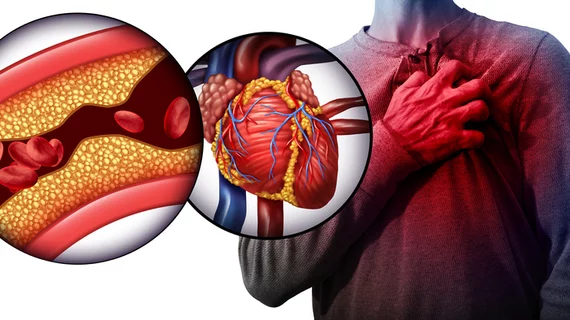Bone density scans show promise for predicting atherosclerotic cardiovascular disease
Bone density scans may assist in evaluating women’s risk of atherosclerotic cardiovascular disease, according to new findings published in the journal Heart.
Both ASCVD and osteoporosis are significant age-related diseases and past studies have suggested they may often arise at similar time periods, hinting at a potential association between the two.
“Since bone densitometry forms part of screening for osteoporosis particularly in middle-aged and older women, it is therefore a tantalizing idea if the same assessment could also be used to assess ASCVD risk,” Dexter Canoy, MD, PhD, and Kazem Rahimi, DM, MSc, both with the University of Oxford in England, wrote Friday in an accompanying editorial.
Dual-energy X-ray absorptiometry exams performed in more than 12,500 women showed this may in fact be feasible. DXA revealed multiple independent predictors of ASCVD events, including death, myocardial infarction, and ischemic stroke, researchers reported May 7.
And adding bone mineral density (BMD) to the equation improved assessments for this specific form of cardiovascular disease, which is a top killer across the globe.
“Considering that dual-energy X-ray absorptiometry is widely used to screen for osteopenia and osteoporosis in asymptomatic women, the significant association between BMD and higher risk of ASCVD provides an opportunity for large-scale ASCVD risk assessment in women without additional cost and radiation exposure,” Jiesuck Park, with Seoul National University Bundang Hospital’s Cardiovascular Center, and colleagues explained in their study.
For their investigations, Park et al. retrospectively analyzed 12,681 women ages 50-80 years who underwent dual-energy X-ray absorptiometry. Of this total, 468 women or 3.7% suffered an ASCVD event at follow-up (median 9.2 years).
Additional independent factors associated with ASCVD included: lower BMD at the lumbar spine, femur neck and total hip, the authors reported.
Editorialists Canoy and Rahimi noted that although DXA is ideal for osteoporosis screening, it may not always be available in other practice settings. Alternative and simpler methods, they noted, could be just as predictive as bone scans.
“Further investigations are needed to evaluate economic costs in specific healthcare settings as well as possible harms,” the pair urged May 7. “Replicating this study in other healthcare settings and populations as well as among men would be very useful.”
Read the entire May 7 study published in Heart here and the accompanying editorial here.

